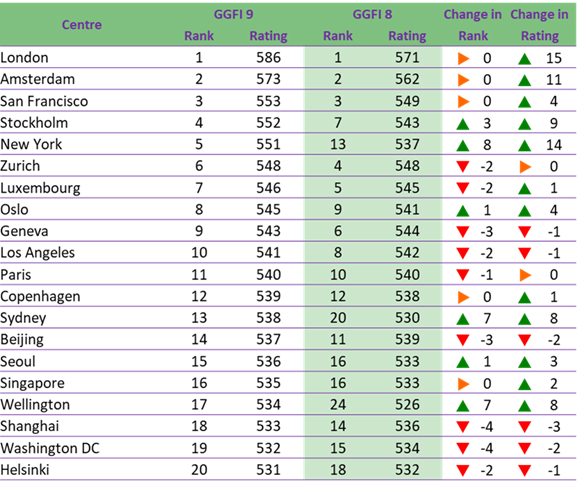The ninth edition of the Global Green Finance Index (GGFI) evaluates the green finance offering of 81 financial centres. The GGFI serves as a valuable measure of the development of green finance for policy and investment decision-makers. The top 20 centres in GGFI 9 are shown in the table below.

GGFI 9 Headlines
- London and Amsterdam maintained their first and second positions in GGFI 9, both improving their rating by more than 10 points.
- London may have benefitted from both recent UK government action on green finance, including the issue of the first UK sovereign green bond, and from its position as host of COP 26.
- New York moved into the top 10, taking fifth place.
- The margins separating centres at the top of the index have broadened in GGFI 9. Among the top 10 centres the spread of ratings is 45 out of 1,000, compared to 31 out of 1,000 in GGFI 8.
- Asia/Pacific centres again performed strongly, with Beijing, Shanghai, Seoul, and Singapore all consolidating gains.
- We researched 126 financial centres for GGFI 9. The number of centres in the index has increased to 81 (80 in GGFI 8), with the addition of Santiago.
GGFI 9 includes a supplement on the issuance of the first Sovereign Sustainability–Linked Bond by the Republic of Chile, and the implications of this new product for both the sovereign bond and green bond markets. The concept of policy performance bonds was developed by Z/Yen in 2005 and they have been used in the corporate world in recent years. This is the first example of a sovereign policy performance bond.
Full details of GGFI 9 can be found at www.greenfinanceindex.net.
Professor Michael Mainelli, Executive Chairman of Z/Yen Group, said: “The challenge to western Europe from North American and Asia/Pacific centres continues showing the global nature of the green finance challenge. We focus in this edition of the GGFI on Chile’s adoption of a sovereign sustainability-linked bond, which focuses on sustainability outcomes. The use of these policy performance bonds may be key to addressing the risk of political instability through a long-term commitment by countries to achieving their sustainability goals.”




